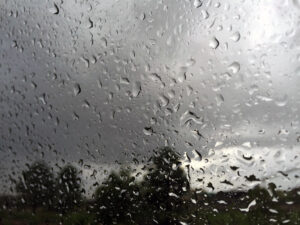It’s the second year in a row the monsoon has gone largely missing, which leads me to a dire if irrational thought: maybe the wall is working. Because the purpose of the wall has always been more than the practical matter of deflecting people from crossing on foot. It’s been more about deflecting the whole idea of the South. It has been a symbol of how thoroughly many want not to be confronted with the reality of places where skins are darker, where people live closer to the bone, where the indecipherable languages are always going to sound like a threat, where the very existence of so many diverse ways of living casts into doubt the easy certainty that ours is the best way.
And so I tend to think of the wall as inseparable from the way in which our own nation is the leader in changing the world’s climate, because the South is where the new pace of change is affecting lives more deeply than it is north of the border, at least for now, and it is largely the new unpredictability of drought and flood and famine that is sending poor people north in their desperation. And so from a certain point of view it makes sense to think of the wall, that desperate presidential declaration of might, as something like the giant ice wall in Game of Thrones, a bulwark so high and so mighty that it can even keep out the way the weather is changing down south.
As a physical conception it’s pretty obvious that this way of thinking has holes in it—hell, the wall itself as a structure has holes in it—but as a symbol the wall is one more way of expressing an increasingly desperate flavor of American exceptionalism, the one that says Global warming? Global’s not us! Global is the rest of the world.
As a July of patchy and highly localized rains gives way to a so-far achingly dry August, it is hard to avoid the thought that something is truly and deeply amiss. Last year, during a dry monsoon season, I was skeptical about the way friends would so readily point to climate change as the cause. The monsoon’s always been unpredictable, I’d point out, and the science on how it interacts with climate change is not nearly as clear as that which suggests a warming and drying trend in the Southwest winters. Much that same language is in a book I’m writing about climate change, which includes the thought that our senses are pretty flawed tools for detecting gradual change. And so comes another dire thought: not only do I have to keep watering the vegetable garden every damn morning during a season in which I’d expected only ease and lushness and a ready harvest, I may also have to change the argument of that part of the book. It’s hard when reality smashes up into what seems a well-formed idea.
Still, it’s ridiculous to think that the building of a wall along our southern border would have anything to do with the widespread failure of a life-giving weather pattern coming up from the south. Right? Could the dreams of those who would seal off our nation be coming true to that extent? If so they would be succeeding primarily in making the Southwest a far less livable place. It’s easy to imagine the language: an invasion of moisture coming up from the south, caravans of clouds massing, illegal border crossings all through the Chihuahuan Desert and the sky islands. Why should the clouds of Mexico darken Arizona skies? Shouldn’t our skies be seeded with American thunderheads?
These are the thoughts that drift like cumulonimbi through the too-warm evenings when I can’t quite sleep, the sort of renegade juxtapositions that make all the sense in the world during dreamtime but slip into absurdity the moment we wake. I suppose seeing climate change happen—or feeling it happen—is like that: there is such a disconnect between the magnitude of the change we are experiencing and the comfortable certitude we were brought up to believe in that the feelings themselves make no sense. Could it be that the monsoon will no longer be a regular feature of the summers as our giant global experiment continues? What other foundations are shaking?
The thought is chilling, and it’s not the sort of chill I crave in these hot months. That’s a different sensation, and one I did get in July. Three weeks ago we experienced our last, for now, monsoon storm, up on the Kaibab Plateau. We drove south from Jacob Lake toward the place where we wanted to camp. It’s a winding road atop the plateau, and with each twist and turn the view of sky changed. To the east and southeast the sky was slate gray with a deep dark monsoon cloud. To the southwest, nothing but blue skies. Which way was the weather moving? we wondered. Was the rain coming or going? As we came around another turn we saw the answer: the storm had just passed, and its signature was drifts of pea-sized hail on the roadside.
We couldn’t help but stop and dig our hands into the new ice. We’d come up from the heat and here we were, shivering in our hastily donned fleeces, flinging loose hail balls at one another, in a sort of giddy shock of surprise. To the east we could see the bank of dark cloud pulling rapidly itself away from us, and it didn’t return.


